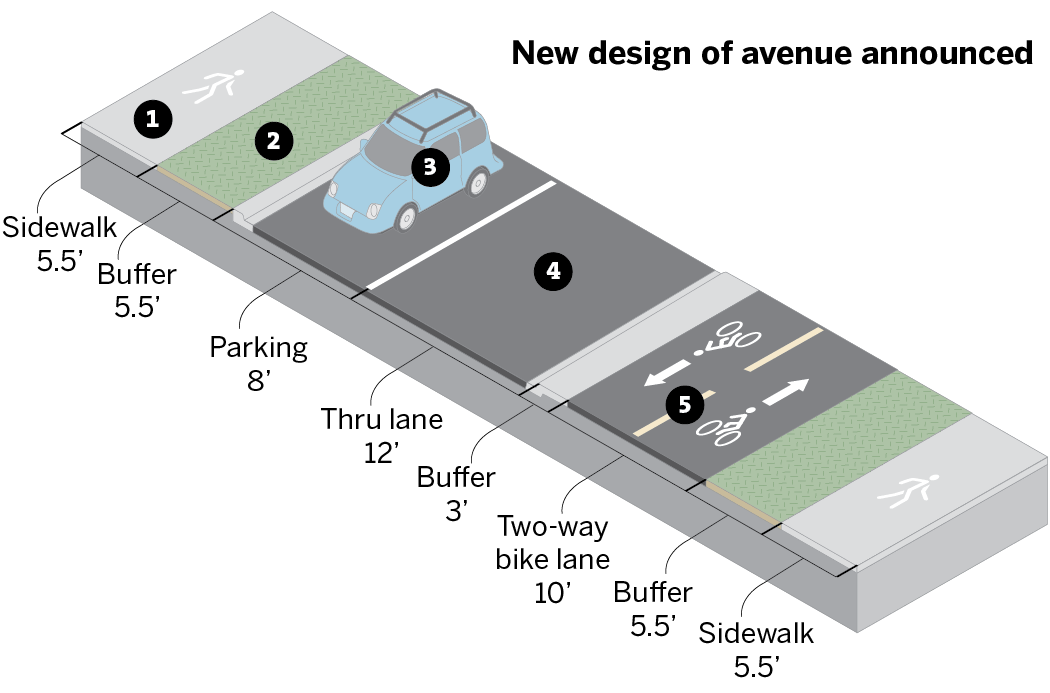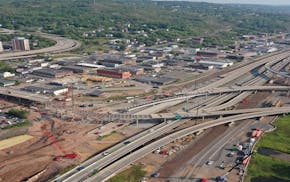A "bold and transformational" reconstruction of Bryant Avenue in south Minneapolis has turned out to be something of a headache.
The bike- and pedestrian-friendly project, half of which was completed last year, has resulted in a street too narrow for fire trucks, snowplows and garbage trucks — as well as some residents whose driveways are on the street.
Now Minneapolis city officials are scrambling to come up with new engineering plans, drawing scrutiny at the same time from some people surprised by the rapid changes.
At a series of public meetings Thursday, city officials apologized for the problems and rolled out a new design for the stretch of the project now under construction. They explained that they're not yet sure what they'll do about the parts already completed.
"We missed this one," Public Works Director Margaret Anderson Kelliher told a City Council committee Thursday, referring to how a host of city departments, including fire and emergency medical services, had agreed in 2021 to a design they thought would work ... until reality set in.
'Cutting-edge street'
The $27.6 million project aimed to completely rebuild, even reinvent, the 2-mile stretch of Bryant Avenue S. between Lake and 50th streets.
What had been a tattered and drab stretch of concrete and pavement where cars and bikes fought for space would be reborn as an environmentally friendly multimodal corridor — where drivers, cyclists and pedestrians could have their own real estate, safely demarcated by green strips of earth that would beautify the landscape and cleanse storm runoff.
The street would be one-way, with bump-outs and chicanes to narrow the street and force drivers to slow down.
Rethinking Bryant Avenue

Dividing up the space
The original plan wasn't without controversy. Some residents and merchants were opposed because it eliminated about half of the parking spaces. But many hailed it as a vision of the future of urban transportation design, and the City Council approved it in August 2021.
Construction began last year on Phase 1, between 50th and 42nd streets, and mostly wrapped up in the late fall. After Anderson Kelliher drove the finished portion, she called it "probably the most cutting-edge street in the state of Minnesota."
But it didn't work.
"We were very quickly into the winter alerted by both fire and EMS that they're having significant issues," Anderson Kelliher said, emphasizing that problems were apparent before the heavy snowfalls piled up.
Here's a sampling of those challenges:
- Driver's-side parking — on the left side of the street — was a failure. Many motorists parked well off the curb, especially once snowbanks formed, narrowing the street more than expected.
- Residents with driveways found the street too tight to back out. Some began to drive on the bikeway to get in and out safely.
- Stretches were too narrow for garbage trucks and plow trucks. The city began sending pickups to plow Bryant, which is a snow emergency route.
- At one point, a fire truck couldn't squeeze through, forcing it to back its way up the block. It wasn't on an emergency call, but officials said this sort of "life safety" risk was unacceptable.
City Council Vice President Linea Palmisano, whose 13th Ward encompasses the reconstructed stretch of Bryant, said her office received hundreds of emails and dozens of phone calls expressing "absolute desperation and pleas for help from our residents ... and from our own city staff."
She added that she was frustrated it had come to this. "I'm not happy with how we, as a city, could not have predicted that outcome," she said.
The fix
City Transportation Director Jeni Hager acknowledged the Public Works Department ultimately deserves blame. "We thought we had it right, and we didn't," she said Friday.
Hager and others in the city last week rolled out revised designs for Phase 2, between 42nd and Lake streets, where crews began working April 10. The changes will raise the project's total cost, but Hager emphasized overruns will be borne by the city and that special assessments for residents won't rise.
"We know this feels fast, because it is," Hager told council members, noting that the redesign plan was going to contractors even as the work was underway.
She apologized for what she and Anderson Kelliher acknowledged wasn't the smoothest way to communicate the sudden changes, which left some supporters of the original design crying foul and accusing the city of changing course without transparency.
Hager, Anderson Kelliher and other public works officials said they're confident the changes adhere to the original vision while ensuring that emergency vehicles will be able to operate on the street.
Among the changes in the new designs:
- Driver's-side parking was scrapped, reducing the amount of parking on that stretch of Bryant by an estimated 26%.
- A strip of green space has been moved to allow for a concrete buffer between the street and the bike lanes. Both the buffer and the bikeway remain elevated at sidewalk level, but a slightly lower curb will allow emergency vehicles to drive on the area in a pinch.
- The amount of green space will be reduced by an estimated 13%.
As for fixing Phase 1 — the part of Bryant that's already done — officials said they haven't figured it out yet but that the work won't be ripped up. They expect to spend the spring and summer examining each block in detail.

State's fastest paddler. Guinness record holder takes aim at Minnesota.
Walz selects leader for new state agency focused on children and families

Parts of Twin Ports Interchange project could open in fall; completion is in sight
Man sentenced to 16 years for fatal sucker punch on St. Paul light rail platform

